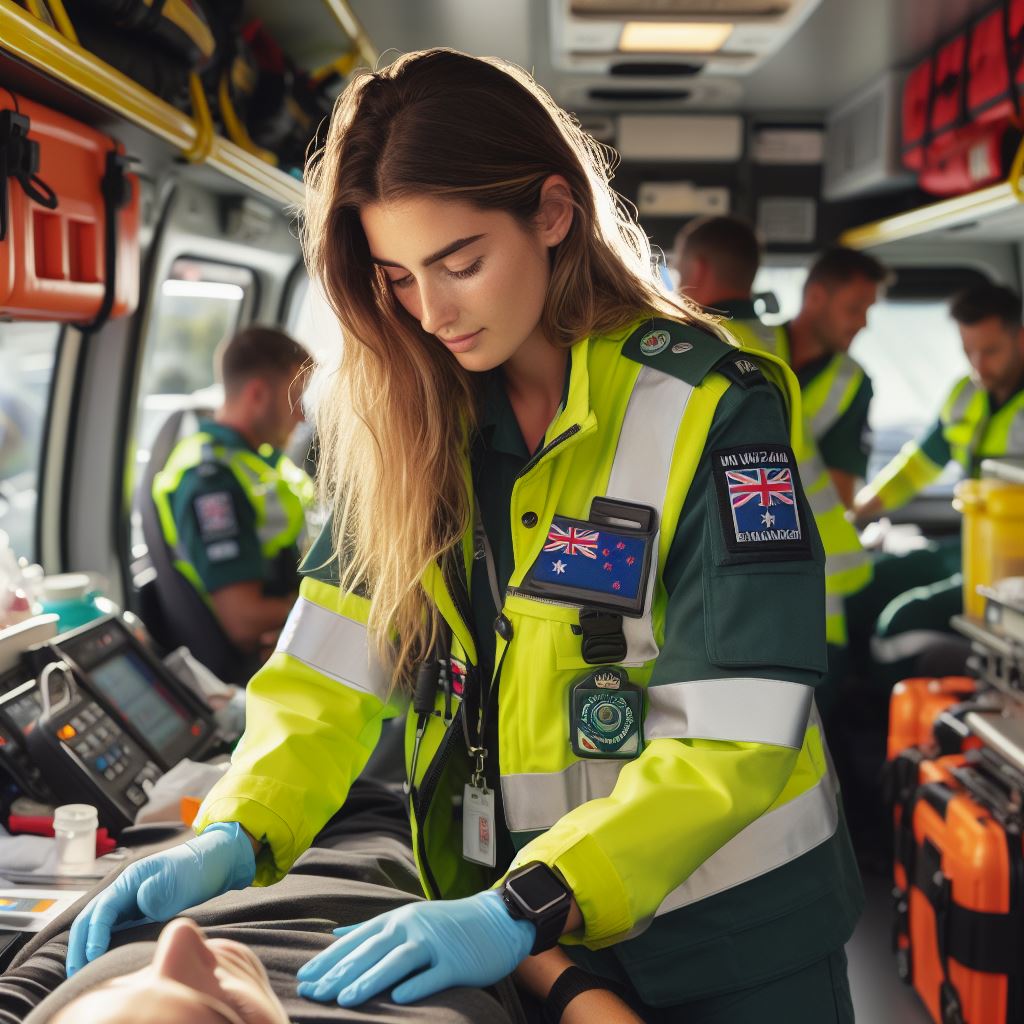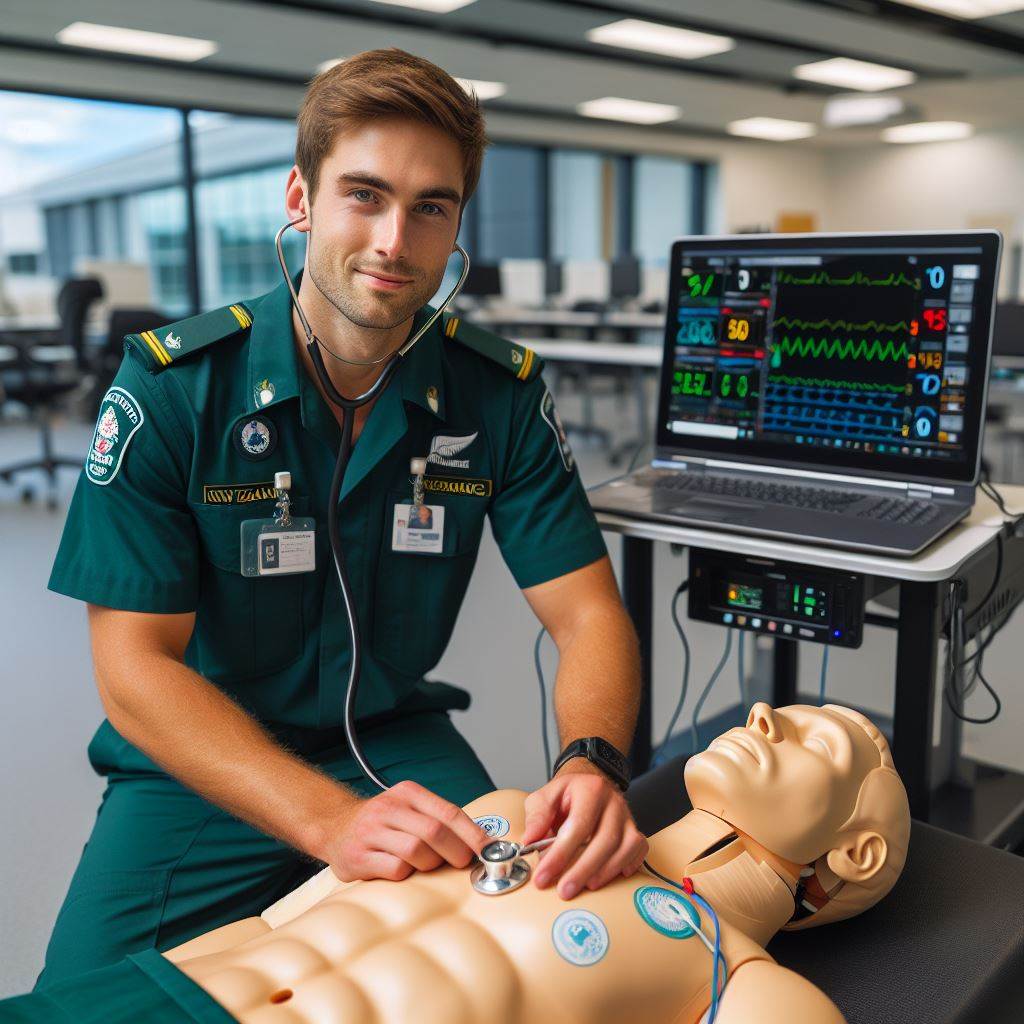Introduction
In recent years, the paramedicine field in New Zealand has witnessed a significant increase in female representation.
This growing trend reflects the changing dynamics and evolving roles within the paramedic profession.
More women are pursuing careers in paramedicine, contributing their unique skills and perspectives to the field.
In this section, we explore the reasons behind this trend and its implications for the paramedic workforce.
We delve into the factors driving women to choose paramedicine as a career path.
Additionally, we examine the challenges and opportunities that female paramedics encounter in their professional journey.
Through firsthand accounts and statistical data, we gain insights into the experiences of women in paramedicine.
Furthermore, we discuss the impact of gender diversity on the paramedic workforce and patient care outcomes.
As the paramedicine landscape continues to evolve, understanding the role of women is essential.
Join us as we explore the rising presence of women in paramedicine and its significance for New Zealand’s healthcare system.
Historical Perspective
In this section, we will discuss the earliest known female paramedics in New Zealand and the challenges they faced entering the field.
Earliest Known Female Paramedics in NZ
- Emily Adams is recognized as one of the earliest female paramedics in New Zealand.
- Adams joined the St. John Ambulance Service in the early 1970s, breaking gender barriers.
- She was passionate about helping others and wanted to make a difference in emergency medical care.
- Adams faced resistance and skepticism from some male colleagues who doubted her abilities.
- Despite the challenges, Adams proved herself and gained respect as a competent paramedic.
Challenges Faced by Women in the Past
- During the early days of paramedicine in New Zealand, it was a predominantly male-dominated profession.
- Women entering the field often faced discrimination, stereotypes, and unequal opportunities.
- Some believed that women lacked the physical strength and stamina required for the job.
- Female paramedics had to work harder to prove their skills and capabilities in a demanding environment.
- There were instances of active discouragement from male colleagues and supervisors.
Progress Made Over the Years in Terms of Gender Equality
- Over time, the perception of paramedicine as a male-only profession shifted.
- Women began to break through the barriers, supported by their competence and dedication.
- Through their hard work and perseverance, more women joined the paramedic workforce.
- Organizations like St John actively encouraged diversity and created equal opportunities for all.
- Today, gender equality is progressively becoming the norm in New Zealand’s paramedicine field.
Current Status of Women in Paramedicine
Statistics and data on the percentage of women in the paramedicine workforce in NZ:
- According to recent statistics, women make up approximately 39% of the paramedicine workforce in New Zealand.
- This percentage has been steadily increasing over the past decade, highlighting a growing trend of women entering the field.
- These figures demonstrate a significant shift towards gender equality within the profession.
- While still a minority, the presence of women in paramedicine is becoming increasingly prominent.
Comparison of gender representation in different regions or cities
- Gender representation can vary across different regions and cities in New Zealand.
- In some areas, the percentage of women in paramedicine may be higher than the national average.
- This can be attributed to various factors such as local recruitment efforts and supportive work environments.
- However, gender disparities still exist, and certain regions may have a lower percentage of women in the field.
Overview of various roles and positions held by women in the field
- Women in paramedicine hold various roles and positions, ranging from paramedics to leadership positions.
- Many women serve as frontline paramedics, providing emergency medical care and support.
- Others specialize in areas such as critical care, pediatric paramedicine, and search and rescue.
- Women also hold positions in management, education, and research within the paramedicine field.
- These roles showcase the wide range of opportunities available for women in the industry.
- They contribute to the overall development and advancement of paramedicine as a profession.
Basically, the current status of women in paramedicine in New Zealand is steadily progressing.
The percentage of women in the paramedicine workforce is increasing, with a national average of approximately 39%.
There are regional variations in gender representation, with some areas demonstrating higher percentages of women.
Women in paramedicine hold various roles and positions, contributing to the advancement of the profession.
Personalized Career Consulting
Unlock your potential with expert career advice tailored to your goals. Get personalized guidance and actionable steps toward your dream career in New Zealand.
Get StartedThis growing trend reflects a positive change towards gender equality and inclusivity within the field.
Overall, women in paramedicine are making significant strides and breaking barriers, paving the way for future generations.
Benefits of having Women in Paramedicine
Women are increasingly joining the paramedicine profession in New Zealand, bringing with them numerous benefits.
The diverse perspectives and approaches that women offer in paramedicine enrich the field and improve patient care and outcomes.
Moreover, their presence has a positive impact on teamwork and communication within paramedic teams.
Diverse Perspectives and Approaches
Having women in paramedicine brings a much-needed diversity of perspectives and approaches.
Women may have different life experiences and backgrounds compared to their male counterparts, enabling them to offer unique insights in providing emergency medical care.
This diversity leads to a more comprehensive understanding of patients’ needs and assists in creating tailored treatment plans.
Improved Patient Care and Outcomes
The inclusion of women in paramedicine results in improved patient care and outcomes.
Women often possess excellent communication and empathy skills, which are crucial in emergency situations.
They have the ability to establish rapport quickly, helping patients feel more at ease and increasing their willingness to cooperate. This ultimately leads to better patient outcomes and satisfaction.
Additionally, studies have shown that female paramedics display higher levels of emotional intelligence, which allows them to effectively manage potentially stressful and chaotic situations.
This emotional intelligence helps deescalate tense situations and supports patients and their families during times of crisis.
Positive Impact on Teamwork and Communication
The presence of female paramedics positively impacts teamwork and communication within paramedic teams.
Collaborative working environments benefit from diverse teams, as each member brings their unique strengths and skills to the table.
Women often excel in building relationships and promoting cooperation among team members.
Female paramedics can contribute to improved communication within the team by fostering open dialogue and ensuring that all perspectives are considered.
This leads to better decision-making and more effective emergency response.
Furthermore, their ability to establish rapport with patients helps create an atmosphere of trust and enhances overall team dynamics.
The Role of Mentorship
Mentorship programs that support women in paramedicine play a crucial role in ensuring their success and retention in the field.
These programs provide valuable guidance, support, and career development opportunities to aspiring female paramedics.
Female mentors serve as powerful role models, inspiring and encouraging other women to pursue careers in paramedicine.
The growing trend of women in paramedicine in New Zealand brings significant benefits to the field. Their diverse perspectives and approaches lead to improved patient care and outcomes.
Moreover, their positive impact on teamwork and communication enhances overall paramedic team dynamics.
Mentorship programs further contribute to the success and development of women in this profession.
Encouraging and supporting more women to join paramedicine will undoubtedly result in a more inclusive and effective emergency medical service.
Read: NZ Healthcare System: Doctors’ Crucial Role
Promoting Gender Equality in Paramedicine
Efforts made by the government, organizations, and educational institutions
- Implementing policies and initiatives that promote gender equality in paramedicine.
- Providing scholarships and financial aid specifically targeted towards female students in paramedicine.
- Collaborating with organizations and institutions to create awareness about opportunities in paramedicine for women.
- Conducting workshops and seminars to educate people about the importance of diversity in the field.
- Establishing mentorship programs to support aspiring female paramedics throughout their education and career.
Strategies to attract and retain more women in paramedicine
- Developing recruitment campaigns that highlight the achievements and success stories of female paramedics.
- Offering flexible work schedules to accommodate the needs of women with family responsibilities.
- Creating safe and inclusive work environments that promote respect and equal treatment.
- Providing training programs to help women advance in their careers and take on leadership roles.
- Encouraging peer support and networking opportunities to foster a sense of community among female paramedics.
Discussing the need for mentoring and support programs for female paramedics
- Mentoring programs can provide guidance and support to female paramedics, helping them navigate challenges.
- Support programs offer a platform to discuss issues specific to women in paramedicine and provide solutions.
- Mentorship and support can help enhance confidence, skills, and career development of female paramedics.
- Increased representation of female mentors and leaders can inspire and motivate other women in the field.
- The provision of mentorship and support programs acknowledges the unique experiences and challenges faced by female paramedics.
Therefore, promoting gender equality in paramedicine requires collaborative efforts from the government, organizations, educational institutions, and the paramedic community itself.
By implementing policies, offering support, and creating inclusive environments, more women can be attracted and retained in paramedicine.
Mentorship and support programs play a crucial role in the professional growth and development of female paramedics, ensuring they receive the guidance and encouragement they need to succeed.
With these strategies in place, the trend of more women entering and thriving in the field of paramedicine in New Zealand can continue to grow.
Women in Medicine: NZ Doctor Profiles

Success Stories and Inspirational Figures
- Rachel Thompson, the first female paramedic in New Zealand, paved the way for women in the profession.
- Thompson’s dedication and passion for helping others inspired many young women to pursue a career in paramedicine.
- Emma Robertson, another trailblazing paramedic, saved countless lives during her tenure.
- Robertson’s exceptional medical skills and ability to remain calm under pressure made her a role model for aspiring paramedics.
- Kate Johnson, a paramedic with over a decade of experience, has received numerous awards for her outstanding contributions.
- Johnson’s commitment to patient care and her innovative approach to emergency situations are worth mentioning.
- Samara Collins, a young paramedic, quickly gained recognition for her bravery and quick thinking in critical situations.
- Collins’s determination and empathy towards patients have made her a respected figure among her peers.
- Stephanie Walsh’s story of perseverance and triumph over adversity serves as an inspiration to many.
- Despite facing hurdles, Walsh became a highly skilled paramedic and constantly strives to improve healthcare in her community.
Highlighting notable achievements by women in paramedicine in NZ
- In 2019, the New Zealand Paramedic Association recognized the outstanding contributions of women in the field.
- Lisa Anderson, a seasoned paramedic, was honored for her exceptional leadership and service.
- Anderson’s tireless dedication to improving patient outcomes and mentoring younger paramedics had a lasting impact.
- Marie Mitchell, a paramedic specializing in rural healthcare, received accolades for her commitment to serving remote communities.
- Mitchell’s efforts to bridge the healthcare gap in rural areas have made her a respected figure in the industry.
- The NZ Women in Paramedicine Network, founded in 2017, aims to support and empower women in the profession.
- The network organizes events and workshops to foster professional growth and networking opportunities for female paramedics.
- Women in paramedicine often face unique challenges, such as balancing work and family responsibilities.
- The inspiring achievements of women in the field serve as a reminder of the limitless potential for female paramedics.
Sharing personal stories of female paramedics who have made a difference
- Rebecca Adams, a paramedic, recalls a heart-wrenching incident that motivated her to pursue a career in the field.
- Adams’s determination to prevent similar tragedies has driven her to excel in her role as a paramedic.
- Emma Thompson remembers a critical situation where her calm demeanor and quick actions saved a patient’s life.
- Thompson’s story highlights the importance of remaining composed in high-pressure scenarios.
- Sarah Roberts shares her experiences in providing emergency medical care during natural disasters and major accidents.
- Roberts’s bravery and adaptability demonstrate the crucial role of paramedics in crisis situations.
- Jessica Turner, a recent graduate, shares her journey of overcoming self-doubt to become a confident and skilled paramedic.
- Turner’s story inspires aspiring female paramedics to pursue their dreams, despite any insecurities they may face.
Showcasing role models to inspire aspiring female paramedics
- Having role models like Rachel Thompson gives aspiring female paramedics the confidence to break barriers and excel.
- The accomplishments of women like Kate Johnson and Stephanie Walsh serve as beacons of hope and motivation.
- The stories of Emma Robertson, Samara Collins, and Marie Mitchell inspire young women to believe in their capabilities.
- Organizations like the NZ Women in Paramedicine Network provide support and mentorship to aspiring female paramedics.
- By highlighting the achievements and personal stories of women in paramedicine, we aim to inspire future generations.
Read: Emergency Medicine in NZ: Inside Look
Transform Your Career with a Professional CV and Cover Letter
Stand out to employers with an ATS-optimized resume and tailored cover letter designed to match your dream role. Let us craft your job application materials for success!
Get StartedChallenges and Solutions
As women in paramedicine continue to break barriers and make advancements in the field, it is important to address the remaining challenges they face and find effective solutions to overcome them.
Identifying remaining barriers and obstacles faced by women in the field
- Limited career progression opportunities due to a predominantly male-dominated work environment.
- Gender bias and stereotypes, leading to discrimination and prejudice.
- Lack of support systems and mentorship programs for women in paramedicine.
- Work-life balance challenges, especially for those with caregiving responsibilities.
- Limited representation and inclusivity in leadership positions and decision-making processes.
Discussing potential solutions and initiatives to overcome these challenges
- Implementing policies and practices that promote gender equality, such as diversifying recruitment and promotion panels.
- Establishing mentorship programs to provide guidance and support for women in paramedicine.
- Offering flexible work arrangements, including part-time and job-sharing options, to help achieve work-life balance.
- Encouraging ongoing training and professional development opportunities specifically tailored to women’s needs.
- Creating a supportive and inclusive work culture that actively addresses and challenges gender biases and stereotypes.
Importance of continued efforts to ensure gender equality in paramedicine
- Improved diversity and gender balance in paramedicine lead to better patient care and outcomes.
- Women bring unique perspectives and skills to the field, enhancing overall performance and problem-solving abilities.
- A more inclusive and equal work environment fosters higher job satisfaction and retention rates.
- Gender equality in paramedicine sets a positive example for other industries and contributes to societal progress.
- Continuously striving for gender equality ensures a brighter and more equitable future for all healthcare professionals.
Read: NZ’s Top Medical Facilities: Doctors’ Views
Conclusion
Recap of the main points discussed in the blog post
In closing, this blog post discussed the growing trend of women in paramedicine in NZ.
Throughout the post, we explored the challenges faced by women in this field and the opportunities that have arisen for them.
The main points highlighted were the increasing number of women enrolling in paramedicine programs, the importance of gender diversity in emergency medical services, and the positive impact that women have on patient care.
Encouragement for women interested in paramedicine to pursue their career aspirations
For women who are interested in pursuing a career in paramedicine, it is essential to recognize that this profession welcomes their contributions and offers a supportive environment.
It is encouraging to see the shift in gender dynamics within paramedicine in NZ and the progress being made to achieve equality in this field.
Women should not hesitate to pursue their career aspirations in paramedicine, as they have a valuable role to play.
Final thoughts on the growing trend of women in paramedicine in NZ
In the coming years, we hope to see further growth in the number of women in paramedicine, as well as continued efforts to create an inclusive and diverse workforce.
This growing trend of women in paramedicine is a positive step towards a more equitable healthcare system in New Zealand.




